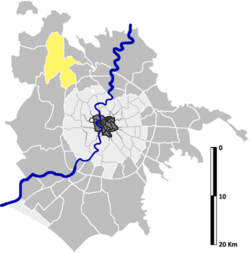La Storta | |
|---|---|
Zona of Rome | |
 The Cathedral of the Sacred Hearts of Jesus and Mary, along the Via Cassia in La Storta | |
 Position of the zona within the city | |
| Country | |
| Region | Lazio |
| Province | Rome |
| Comune | Rome |
| Area | |
• Total | 18.0198 sq mi (46.6710 km2) |
| Population (2016) [1] | |
• Total | 21,283 |
| • Density | 1,181.1/sq mi (456.02/km2) |
| Time zone | UTC+1 (CET) |
| • Summer (DST) | UTC+2 (CEST) |
La Storta is the 51st zona of the Italian capital city, Rome. It is identified by the initials Z. LI and falls within the boundaries of Municipio XV. [note 1]
Contents
- History
- Statio on the Via Francigena
- Vision of Saint Ignatius
- La Storta Massacre
- Ecclesiastical territory
- Geography
- Boundaries
- Odonymy
- Places of interest
- Civil buildings
- Religious buildings
- Military buildings
- Education
- See also
- Notes and references
The name La Storta ("the curve"; literally 'twisted' or 'bent') refers to a series of curves that the Via Cassia makes through the settlement. [3]
